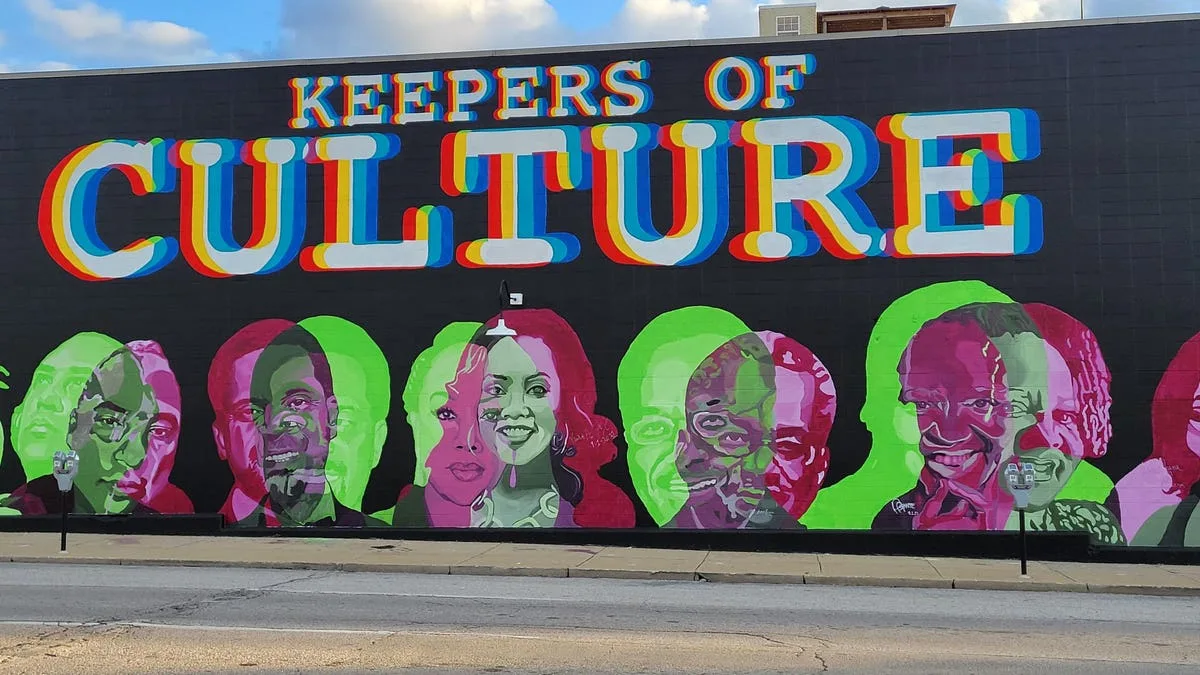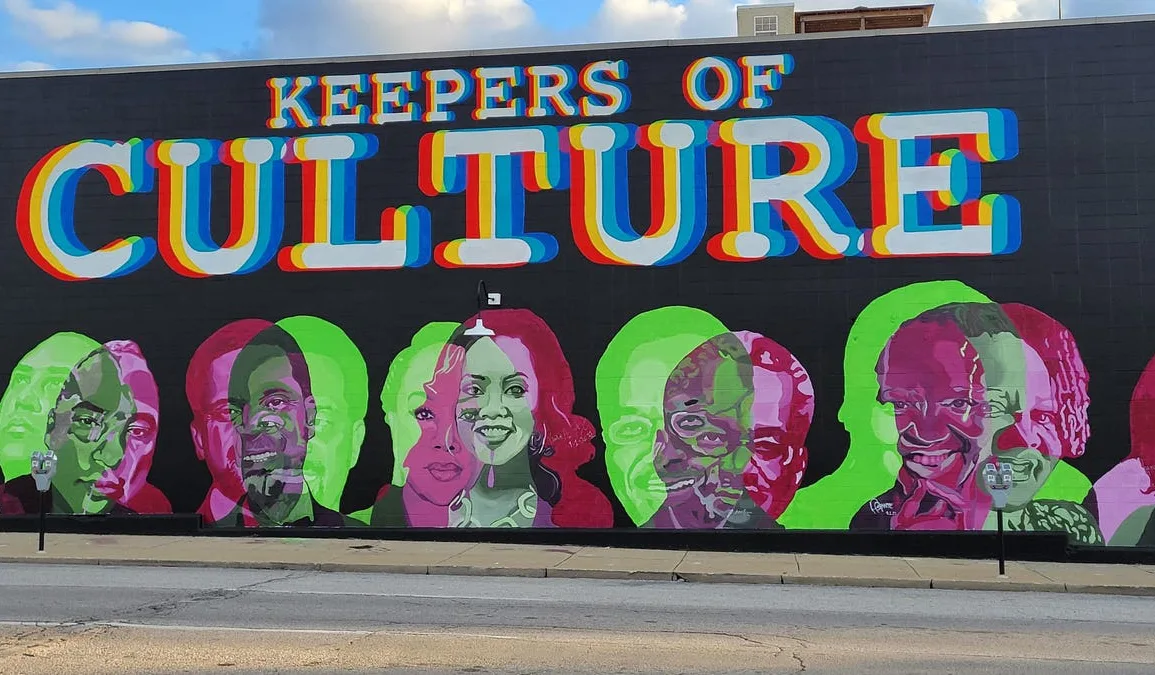
You are in the right place.
Madam C.J. Walker. Oscar Robertson. Mike Epps.
Indiana Avenue. Crispus Attucks High School. BUTTER fine art fair.
“You are in the right place,” Sampson Livingston told a group of BUTTER attendees on his neighborhood history tour around the Stutz Building which hosted the event. “Black art, right where it belongs in a Black neighborhood.”
This is Black excellence.
This is Indianapolis.
And you are, indeed, in the right place.
BUTTER
Attendees enjoying BUTTER fine art fair 2023.
The BUTTER fine art fair debuted in 2021 to immediate acclaim. Here was something unique. An art fair highlighting community, not commodity. BUTTER billed itself as “North America’s equitable fine art fair.”
All of the artists are Black, amplifying not only the worth of their work, but its value to a marketplace continuing to suppress it. Artists receive all proceeds from every sale.
A majority of invited artists are from Indiana, including self-represented artists working outside the gallery system. In addition to highlighting artists overlooked due to their race, BUTTER highlights artists overlooked due to their geography. “Midwest is Best” the fair proclaims.
BUTTER 2023 took place over Labor Day weekend in the 110-year-old Stutz Building, a former auto manufacturing site in downtown Indy along Indiana Avenue. Indiana Avenue was the city’s formerly Black majority neighborhood.
The fair did not choose its location by happenstance.
“The right stuff in the right place,” Livingston said. “They intentionally take Black art out and destroy Black neighborhoods, we put that stuff back in. That’s what BUTTER is all about.”
Indiana Avenue
Indiana Avenue can’t be considered a neighborhood of any kind anymore. All the homes are gone. Racist city planners took care of that under the guise of “urban renewal” in the 50s, 60s, and 70s. What happened here in Indianapolis took place in almost every major city in America: interstates purposefully routed through thriving Black neighborhoods to fracture them.
Those neighborhoods collapsed. Indiana Avenue collapsed.
In the first half of the 20th century, adjacent to the Stutz would have been Black homes, Black churches, the Black Lincoln Hospital and Black businesses including the Ferguson Hotel, a Green Book hotel, across the street.
They’re all gone now.
Interstate 65 runs directly through the area. It couldn’t have been located more precisely to destroy the neighborhood if that had been the planners stated purpose from the outset.
Before the interstate, before the people were pushed out and the cars shoved in, the Stutz was connected to Crispus Attucks High School. You could see one from the other. You can’t anymore. The interstate is elevated, providing a visual barrier as well as a physical one. A sidewalk bridged the half mile between the two, passing by houses and stores.
All gone.
But Attucks is still here, defiant.
Crispus Attucks High School
INDIANAPOLIS, IN – MARCH, 1956: Members of the Crispus Attucks Tigers accept the 1956 Indiana State … [+]
At the turn of the 20th century, Indiana’s schools were integrated. Very progressive. They were re-segregated in the 1920s. Very regressive.
What happened?
Here at the crossroads of America, farmland, heartland, John Mellencamp’s “Pink Houses,” car racing and Hoosier hoops, this was also the epicenter for Ku Klux Klan activity at one time in America. Not Alabama. Not Mississippi. Indiana. A full one quarter of Indiana’s population were card-carrying Klan members in the 1920s. A 1925 Klan rally at the Indiana State Fair had 65,000 attendees.
This disgraceful era is shared in best-selling author Tim Egan’s 2023 book, “A Fever in the Heartland: The Ku Klux Klan’s Plot to Take Over America, and the Woman Who Stopped Them.”
In 1927, Indianapolis forced into existence Thomas Jefferson High School. A segregated high school for Black kids. Black residents weren’t able to keep schools integrated, but they did say hell no to naming the school after a slave holder and changed it to honor the Black Revolutionary era martyr.
“Historically speaking, it was the most despised and rejected high school in America that became the most celebrated high school in America,” Robert Chester, curator of the Crispus Attucks Museum at Crispus Attucks High School, told Forbes.com. “It was the most despised and rejected people being forced into the most despised and rejected part of the city–this was close to the city dump, this was the flood zone, this was considered the bottom, this was the least desirable area. There were so many negatives that caused it to be the most despised and rejected, but through that Black excellence and keeping the right attitude, now it’s the most celebrated.”
Taking the bitter and making it sweet.
Between 1927 and 1970, every Black resident who graduated from high school in Indianapolis, did so from Crispus Attucks High School. Basketball hall of famer Oscar Robertson did. The greatest jazz guitarist to ever work the strings, Wes Montgomery, did. John W. Lee did; he was the first Black officer commissioned in the regular Navy.
Essential to Attucks’ success was its teachers. While Indianapolis told Black students where they could and couldn’t go to school, administrators were given no restrictions on who could or couldn’t be hired as instructors. They recruited the best of the best from around the nation. Attucks’ teachers included the first Black woman admitted to Oxford University, local civil rights leaders, a former Buffalo Soldier, and a Tuskegee Airman. All had at least a master’s degree.
Beyond reading, writing and arithmetic, Attucks’ students were taught pride. Black pride. They were taught Black heritage. Lessons robbed from generations of Black students elsewhere around the nation.
“Not only were we not told our heritage was great, we didn’t even know we had a heritage. We didn’t know we were even deserving of anything great. Everything we saw, heard, from the time we woke up to the time we went to sleep, pointed to white culture, white pride, and everything associated with Black, it was not important,” Chester explains. “Show me a child that grew up in America prior to the 21st century that does not suffer from some kind of inferiority complex, dysfunctionality, you name it, mental deficiencies, all because of the psychotic system we were birthed in, but on that note, the world calls us the strong ones. White culture won’t admit this, but I talk to the world every day, the world comes to me every day, they say there is nowhere in history–which is true–that a people on this planet can claim what you all just went through and survived, and now it’s flourishing beyond imagination.”
Students–Black and white–continue attending Crispus Attucks High School today. Attached to the school gymnasium is the museum where Chester welcomes the world to learn more about Attucks specifically, and Black history and culture more broadly.
Anti-lynching exhibit
On view at the museum through March 10, 2024, is a special exhibition exploring how artists worked to call attention to the nation’s Jim Crow era lynching epidemic. The wave of domestic terror washed across Indiana.
A particularly disturbing section of the exhibition–which is graphic and horrifying throughout–focuses on the 1930 hanging of Abraham Smith, Thomas Shipp and James Cameron in Marion, IN, 70 miles north of Indy. Sixteen-year-old Cameron survived the attack. A famous photo of the murder victims hanging by their necks from a tree limb to the delight of dozens of white onlookers is on view.
“Unfortunately, a great deal of this history has been lost, stolen, strayed, denied, buried, it is imperative though, that this exhibit, and others like it, receive their time in the sun throughout America because we are highlighting not what we consider blood, guts and gore, but a time when something was going on in the mindset that produced an epic response based in fear, ignorance, and who knows what else that would cause man to destroy man in this way,” Chester said.
The Marion hanging was the last recorded racial terror hanging in the northern states.
The image inspired the poem “Strange Fruit,” which became a signature song for Billie Holiday.
“In order to move beyond it, heal from it, make amends with it, make certain that none of it is in vain, we’ve got to confront it first. All that we have endured and overcome as a nation, it could be all in vain if we have not learned from it,” Chester cautions. “If we learn from it and move beyond it and get everything we can get out of it to make us better individually, collectively, and make our beautiful nation better, then none of the past was in vain, but if we continue to repeat the same mistakes, then yes, it’s all in vain.”
Mistakes like suppressing history. Minimizing the horrors of slavery. Banning books. Restricting access to voting. Fostering racial violence. Actions undertaken daily by politicians across America today.
Making amends
Barkley Hendricks ‘Dr. Kool’ (1973) (left); Kyng Rhodes of the Looking Glass Alliance ‘Red Handed’ … [+]
No institution in Indianapolis has more to learn from its past mistakes than Newfields, the umbrella name for the campus the Indianapolis Museum of Art calls home. A racially derogatory job posting in 2021 brought national scorn upon the esteemed institution–long perceived within the broader Indianapolis community as a bastion of stuffy, exclusionary, white elitism.
Colette Pierce Burnette wasn’t aware of that history when a headhunting firm contacted her about becoming Newfields’ President and CEO. Frankly, she wasn’t all that interested. Not until she became aware of the scandal; then she had to have the job.
Burnette’s background wasn’t in the arts. Before coming to Newfields in 2022, she had retired as President and CEO of Huston-Tillotson University—the Historical Black College and University in Austin, TX. There, she integrated a Black institution into a white community. At Newfields, she saw the opportunity to achieve the opposite.
More than a century of prejudice can’t be undone in a year, but Newfields has taken important first steps. “We. The Culture: Works by The Eighteen Art Collective” brought artwork from 18 Indianapolis-based Black artists into the museum.
More lasting, in spring of 2023, the museum updated its American art galleries. In doing so, it invited the Looking Glass Alliance, five local residents, four of whom are Black, three women–artists, activists, educators, researchers–to “turn upside down the white, heteronormative interpretations of art and the American mythos that have traditionally been communicated in museums.”
Black faces and Black voices are now found throughout the American collection, introducing historically overlooked stories and perspectives. None more powerful than Looking Glass Alliance member Tatjana Rebelle’s poem for George Thompkins, a 19-year-old Indianapolis man who’s 1922 death was initially ruled a suicide, only to be–obviously–determined a murder 100 years later. Suicide’s quite a trick with your hands bound behind your back.
Madam C.J. Walker
Madam C.J. Walker mural in downtown Indianapolis.
Madam C.J. Walker wasn’t from Indy–she was born on a cotton plantation in Louisiana, the first of her family born into freedom–but the business that made her America’s first female African American millionaire took off while living there. The 1927 building on Indiana Avenue used to manufacture and distribute her beauty products targeting Black consumers lives on as the Madame Walker Legacy Center.
Indy’s own Mike Epps welcomed the public back to the venue following COVID closures recording a Netflix comedy special there.
In 2022, a $15 million renovation on the building was completed, assuring its presence sharing Walker’s legacy with future generations.
“Give back while you’re still moving forward, that really is her lesson,” Kristian Little Stricklen, President of the Madam Walker Legacy Center, told Forbes.com. “She found a way for other Black women at the time to have another option. Instead of being a washer woman, you can find a skill and then you can have your own business. It wasn’t just about making money for herself, she was showing others how they could better themselves, and then take those lessons and make a better life for themselves and their families.”
Belmont Beach
The Indianapolis schools weren’t the only public spaces to segregate during the 1920s. The parks did as well. That included swimming pools.
The one public pool opened to Black residents was too far for most community members to walk to, so they looked to the river. The White River flows through Indianapolis. During most of the 20th century, particularly during the Jim Crow era prior to passage of the Clean Water Act in 1972, particularly south of the Emrichsville Dam through the Haughville neighborhood, the White River was a toxic, fetid, toilet.
Industrial waste from tanneries and slaughterhouses sited along the river and sewage overflows left it fouled beyond what any white Indy resident would consider wading into. That made it perfect for the Black residents, in their minds.
In a textbook example of environmental racism, Black Indianapolis residents were restricted to accessing only the most polluted stretch of the White River, just south of the Emrichsville Dam, a place called Belmont Beach.
After a century’s worth of litigation, the removal of industry, and the diversion of sewage overflows, the White River is as clean as it’s been since long before anyone’s living memory. Belmont Beach is back too.
In 2021, a group of local volunteers led by Haughville native Ted Hardy cleared an overgrown lot creating a pop-up park at the Emrichsville Dam which failed in 2018. A hedge wall of invasive honeysuckle was removed making the river appear to neighborhood residents once again, as if by magic, after decades.
“It’s brought a lot of joy, a lot of peace, I think it’s opened people’s minds for the future,” Hardy told Forbes.com.
Many community members were initially skeptical.
“People were like, ‘that’s not true–a beach in Indianapolis, on the west side, accessing water and nature,’” Hardy recalls. “So, when that ‘wall’ dropped, it was like a breath of fresh air for myself and the community.”
In its third season, Belmont Beach now hosts regular open mic comedy and music nights, movies and sound bathing–flowing water is heard in Haughville. Families come for picnics, cookouts, fishing, birthday parties and engagements. Hardy proposed to his now-wife there.
Osprey, cormorants, bald eagles, hawks, owls, turtles, muskrat, beaver and butterflies are seen along the White River at Belmont Beach.
Fully restoring this section of the White River will take years and millions of dollars. The dam needs to be removed. The Friends of Belmont Beach and the city are working together to see it happen.
Ted Hardy. Kristian Little Stricklen. Colette Pierce Burnette. Robert Chester. Sampson Livingston.
Black excellence.
Indianapolis.
You are in the right place.



